Impact of Global Macroeconomic Policies on Price Level and GDP Growth
VerifiedAdded on 2023/06/18
|9
|2608
|153
Essay
AI Summary
This essay explores global macroeconomic policies, focusing on monetary and fiscal instruments and their influence on price levels and GDP. It details how monetary policy, involving changes in money supply, interest rates, and exchange rates, is implemented by central banks to achieve economic growth and low inflation. Expansionary and contractionary monetary policies are discussed, highlighting their effects on investment, consumption, and inflation. The role of the money market in facilitating cash management and promoting economic stability is also examined. Furthermore, the essay analyzes fiscal policy, which involves government expenditure and taxation, and its impact on aggregate demand and resource allocation. Discretionary and non-discretionary fiscal policies are compared, with examples of their implementation in the UK. The essay concludes by considering the future of fiscal policy in the UK, emphasizing the importance of adapting job retention schemes, promoting public investments, and managing national response plans to foster economic recovery and sustainable growth. The document is available on Desklib, a platform offering a wide array of study tools and resources for students.
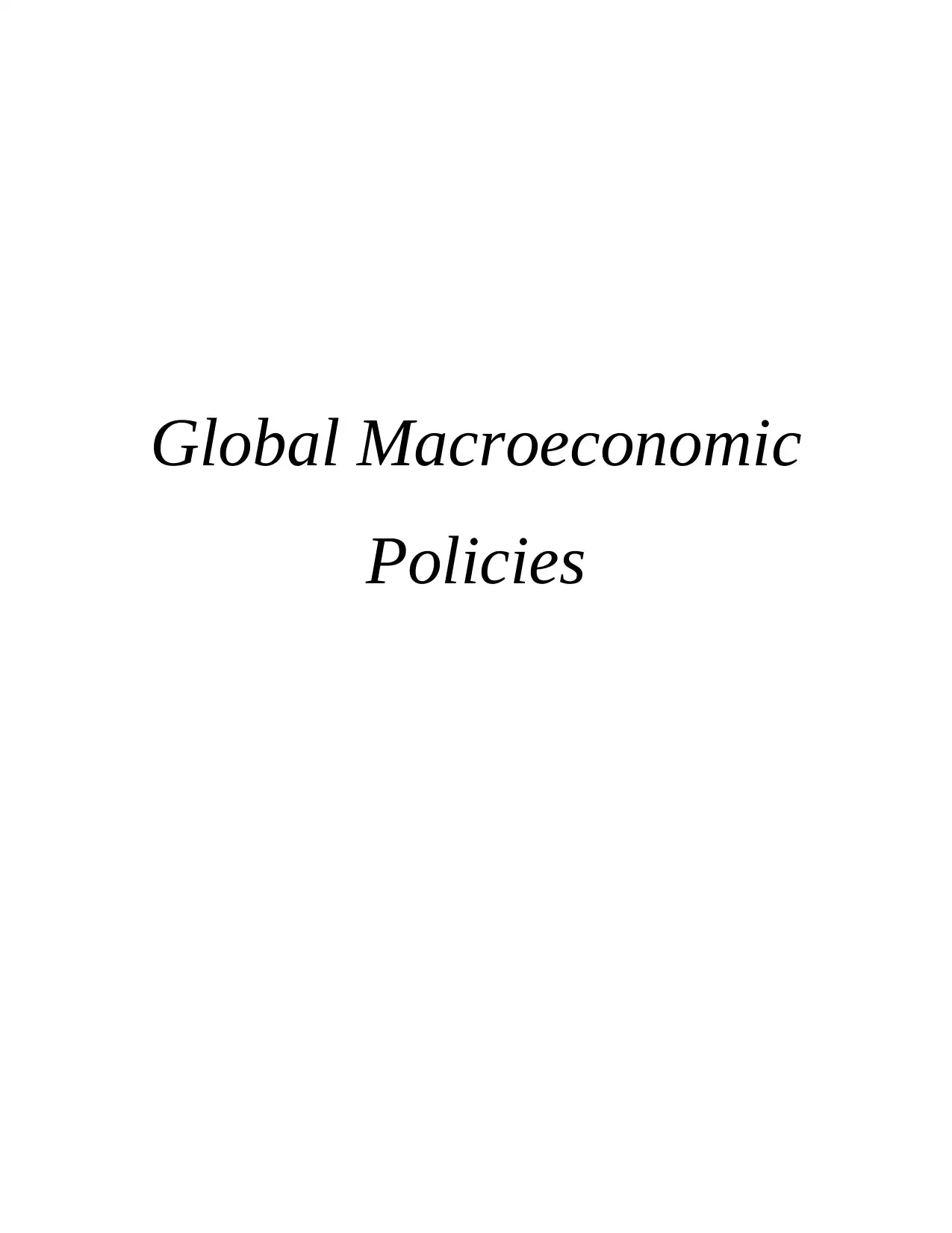
Global Macroeconomic
Policies
Policies
Paraphrase This Document
Need a fresh take? Get an instant paraphrase of this document with our AI Paraphraser
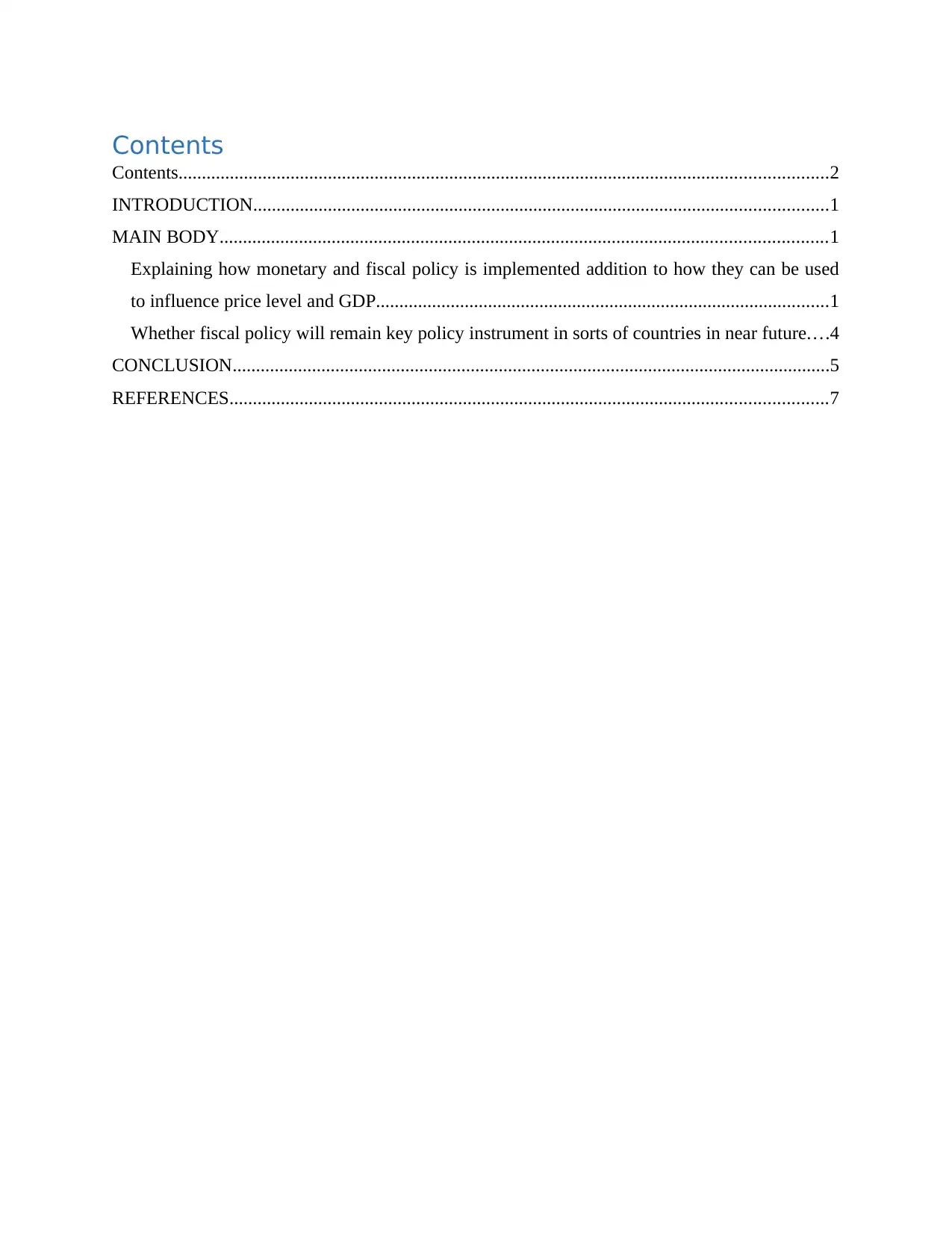
Contents
Contents...........................................................................................................................................2
INTRODUCTION...........................................................................................................................1
MAIN BODY..................................................................................................................................1
Explaining how monetary and fiscal policy is implemented addition to how they can be used
to influence price level and GDP.................................................................................................1
Whether fiscal policy will remain key policy instrument in sorts of countries in near future....4
CONCLUSION................................................................................................................................5
REFERENCES................................................................................................................................7
Contents...........................................................................................................................................2
INTRODUCTION...........................................................................................................................1
MAIN BODY..................................................................................................................................1
Explaining how monetary and fiscal policy is implemented addition to how they can be used
to influence price level and GDP.................................................................................................1
Whether fiscal policy will remain key policy instrument in sorts of countries in near future....4
CONCLUSION................................................................................................................................5
REFERENCES................................................................................................................................7
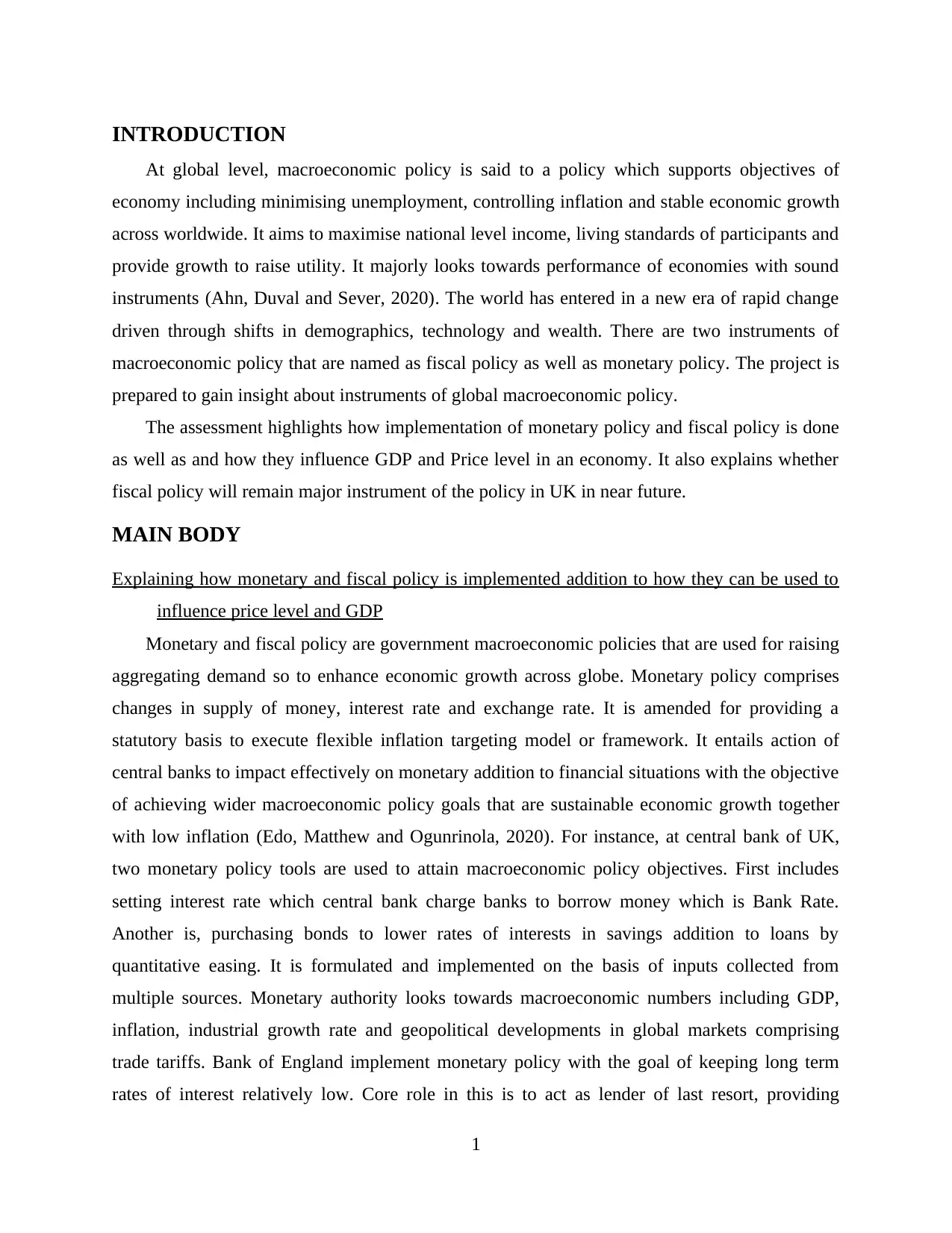
INTRODUCTION
At global level, macroeconomic policy is said to a policy which supports objectives of
economy including minimising unemployment, controlling inflation and stable economic growth
across worldwide. It aims to maximise national level income, living standards of participants and
provide growth to raise utility. It majorly looks towards performance of economies with sound
instruments (Ahn, Duval and Sever, 2020). The world has entered in a new era of rapid change
driven through shifts in demographics, technology and wealth. There are two instruments of
macroeconomic policy that are named as fiscal policy as well as monetary policy. The project is
prepared to gain insight about instruments of global macroeconomic policy.
The assessment highlights how implementation of monetary policy and fiscal policy is done
as well as and how they influence GDP and Price level in an economy. It also explains whether
fiscal policy will remain major instrument of the policy in UK in near future.
MAIN BODY
Explaining how monetary and fiscal policy is implemented addition to how they can be used to
influence price level and GDP
Monetary and fiscal policy are government macroeconomic policies that are used for raising
aggregating demand so to enhance economic growth across globe. Monetary policy comprises
changes in supply of money, interest rate and exchange rate. It is amended for providing a
statutory basis to execute flexible inflation targeting model or framework. It entails action of
central banks to impact effectively on monetary addition to financial situations with the objective
of achieving wider macroeconomic policy goals that are sustainable economic growth together
with low inflation (Edo, Matthew and Ogunrinola, 2020). For instance, at central bank of UK,
two monetary policy tools are used to attain macroeconomic policy objectives. First includes
setting interest rate which central bank charge banks to borrow money which is Bank Rate.
Another is, purchasing bonds to lower rates of interests in savings addition to loans by
quantitative easing. It is formulated and implemented on the basis of inputs collected from
multiple sources. Monetary authority looks towards macroeconomic numbers including GDP,
inflation, industrial growth rate and geopolitical developments in global markets comprising
trade tariffs. Bank of England implement monetary policy with the goal of keeping long term
rates of interest relatively low. Core role in this is to act as lender of last resort, providing
1
At global level, macroeconomic policy is said to a policy which supports objectives of
economy including minimising unemployment, controlling inflation and stable economic growth
across worldwide. It aims to maximise national level income, living standards of participants and
provide growth to raise utility. It majorly looks towards performance of economies with sound
instruments (Ahn, Duval and Sever, 2020). The world has entered in a new era of rapid change
driven through shifts in demographics, technology and wealth. There are two instruments of
macroeconomic policy that are named as fiscal policy as well as monetary policy. The project is
prepared to gain insight about instruments of global macroeconomic policy.
The assessment highlights how implementation of monetary policy and fiscal policy is done
as well as and how they influence GDP and Price level in an economy. It also explains whether
fiscal policy will remain major instrument of the policy in UK in near future.
MAIN BODY
Explaining how monetary and fiscal policy is implemented addition to how they can be used to
influence price level and GDP
Monetary and fiscal policy are government macroeconomic policies that are used for raising
aggregating demand so to enhance economic growth across globe. Monetary policy comprises
changes in supply of money, interest rate and exchange rate. It is amended for providing a
statutory basis to execute flexible inflation targeting model or framework. It entails action of
central banks to impact effectively on monetary addition to financial situations with the objective
of achieving wider macroeconomic policy goals that are sustainable economic growth together
with low inflation (Edo, Matthew and Ogunrinola, 2020). For instance, at central bank of UK,
two monetary policy tools are used to attain macroeconomic policy objectives. First includes
setting interest rate which central bank charge banks to borrow money which is Bank Rate.
Another is, purchasing bonds to lower rates of interests in savings addition to loans by
quantitative easing. It is formulated and implemented on the basis of inputs collected from
multiple sources. Monetary authority looks towards macroeconomic numbers including GDP,
inflation, industrial growth rate and geopolitical developments in global markets comprising
trade tariffs. Bank of England implement monetary policy with the goal of keeping long term
rates of interest relatively low. Core role in this is to act as lender of last resort, providing
1
⊘ This is a preview!⊘
Do you want full access?
Subscribe today to unlock all pages.

Trusted by 1+ million students worldwide
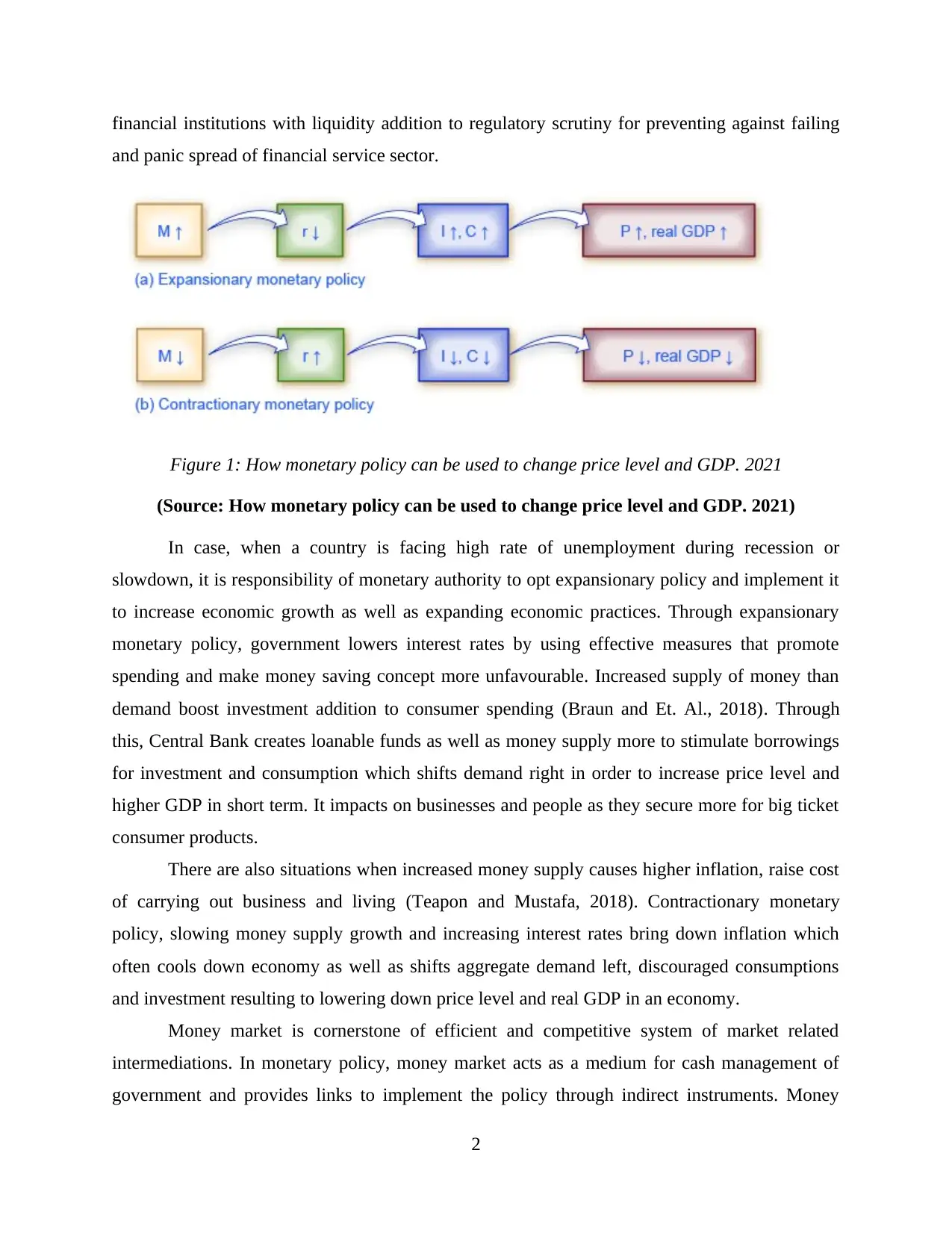
financial institutions with liquidity addition to regulatory scrutiny for preventing against failing
and panic spread of financial service sector.
Figure 1: How monetary policy can be used to change price level and GDP. 2021
(Source: How monetary policy can be used to change price level and GDP. 2021)
In case, when a country is facing high rate of unemployment during recession or
slowdown, it is responsibility of monetary authority to opt expansionary policy and implement it
to increase economic growth as well as expanding economic practices. Through expansionary
monetary policy, government lowers interest rates by using effective measures that promote
spending and make money saving concept more unfavourable. Increased supply of money than
demand boost investment addition to consumer spending (Braun and Et. Al., 2018). Through
this, Central Bank creates loanable funds as well as money supply more to stimulate borrowings
for investment and consumption which shifts demand right in order to increase price level and
higher GDP in short term. It impacts on businesses and people as they secure more for big ticket
consumer products.
There are also situations when increased money supply causes higher inflation, raise cost
of carrying out business and living (Teapon and Mustafa, 2018). Contractionary monetary
policy, slowing money supply growth and increasing interest rates bring down inflation which
often cools down economy as well as shifts aggregate demand left, discouraged consumptions
and investment resulting to lowering down price level and real GDP in an economy.
Money market is cornerstone of efficient and competitive system of market related
intermediations. In monetary policy, money market acts as a medium for cash management of
government and provides links to implement the policy through indirect instruments. Money
2
and panic spread of financial service sector.
Figure 1: How monetary policy can be used to change price level and GDP. 2021
(Source: How monetary policy can be used to change price level and GDP. 2021)
In case, when a country is facing high rate of unemployment during recession or
slowdown, it is responsibility of monetary authority to opt expansionary policy and implement it
to increase economic growth as well as expanding economic practices. Through expansionary
monetary policy, government lowers interest rates by using effective measures that promote
spending and make money saving concept more unfavourable. Increased supply of money than
demand boost investment addition to consumer spending (Braun and Et. Al., 2018). Through
this, Central Bank creates loanable funds as well as money supply more to stimulate borrowings
for investment and consumption which shifts demand right in order to increase price level and
higher GDP in short term. It impacts on businesses and people as they secure more for big ticket
consumer products.
There are also situations when increased money supply causes higher inflation, raise cost
of carrying out business and living (Teapon and Mustafa, 2018). Contractionary monetary
policy, slowing money supply growth and increasing interest rates bring down inflation which
often cools down economy as well as shifts aggregate demand left, discouraged consumptions
and investment resulting to lowering down price level and real GDP in an economy.
Money market is cornerstone of efficient and competitive system of market related
intermediations. In monetary policy, money market acts as a medium for cash management of
government and provides links to implement the policy through indirect instruments. Money
2
Paraphrase This Document
Need a fresh take? Get an instant paraphrase of this document with our AI Paraphraser
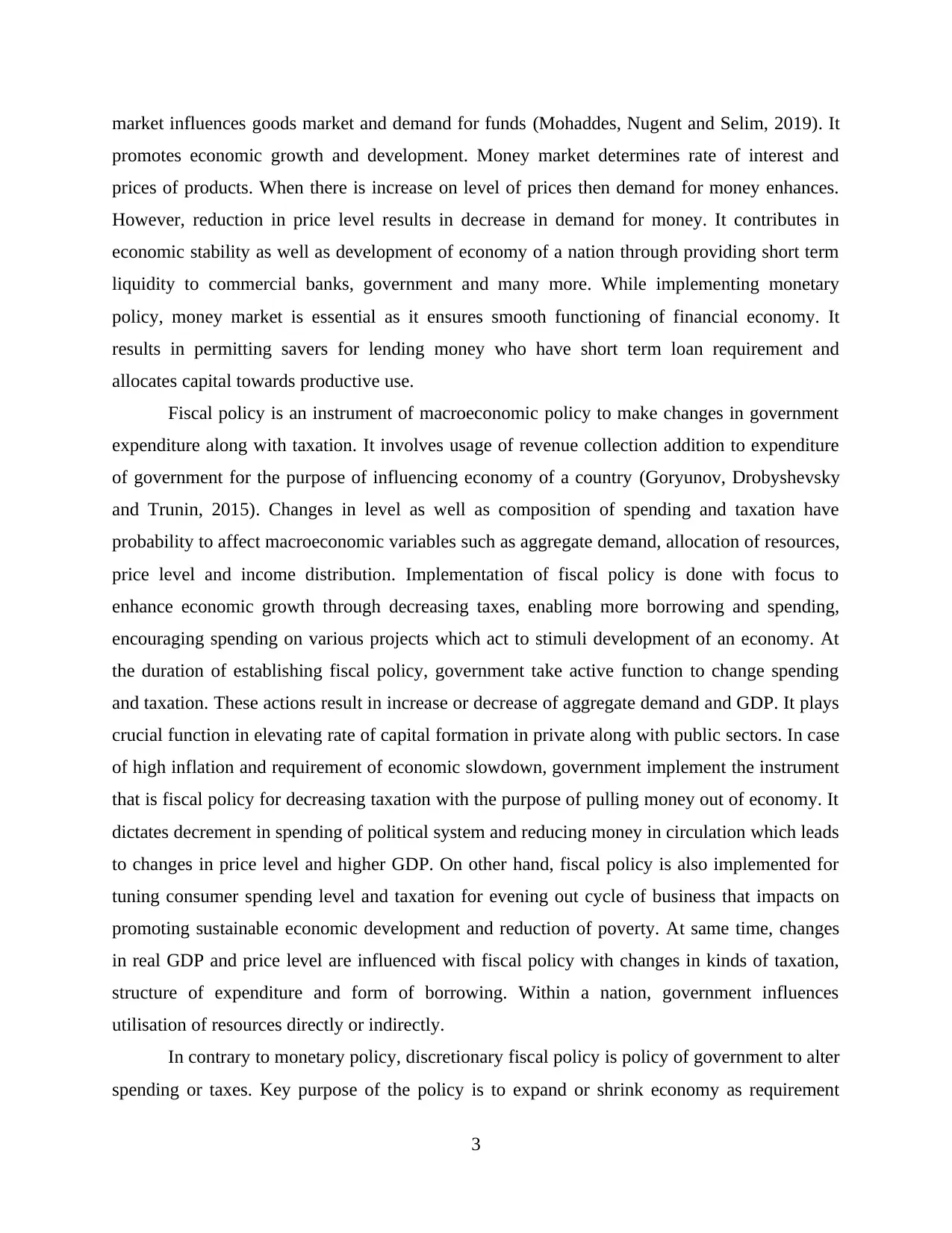
market influences goods market and demand for funds (Mohaddes, Nugent and Selim, 2019). It
promotes economic growth and development. Money market determines rate of interest and
prices of products. When there is increase on level of prices then demand for money enhances.
However, reduction in price level results in decrease in demand for money. It contributes in
economic stability as well as development of economy of a nation through providing short term
liquidity to commercial banks, government and many more. While implementing monetary
policy, money market is essential as it ensures smooth functioning of financial economy. It
results in permitting savers for lending money who have short term loan requirement and
allocates capital towards productive use.
Fiscal policy is an instrument of macroeconomic policy to make changes in government
expenditure along with taxation. It involves usage of revenue collection addition to expenditure
of government for the purpose of influencing economy of a country (Goryunov, Drobyshevsky
and Trunin, 2015). Changes in level as well as composition of spending and taxation have
probability to affect macroeconomic variables such as aggregate demand, allocation of resources,
price level and income distribution. Implementation of fiscal policy is done with focus to
enhance economic growth through decreasing taxes, enabling more borrowing and spending,
encouraging spending on various projects which act to stimuli development of an economy. At
the duration of establishing fiscal policy, government take active function to change spending
and taxation. These actions result in increase or decrease of aggregate demand and GDP. It plays
crucial function in elevating rate of capital formation in private along with public sectors. In case
of high inflation and requirement of economic slowdown, government implement the instrument
that is fiscal policy for decreasing taxation with the purpose of pulling money out of economy. It
dictates decrement in spending of political system and reducing money in circulation which leads
to changes in price level and higher GDP. On other hand, fiscal policy is also implemented for
tuning consumer spending level and taxation for evening out cycle of business that impacts on
promoting sustainable economic development and reduction of poverty. At same time, changes
in real GDP and price level are influenced with fiscal policy with changes in kinds of taxation,
structure of expenditure and form of borrowing. Within a nation, government influences
utilisation of resources directly or indirectly.
In contrary to monetary policy, discretionary fiscal policy is policy of government to alter
spending or taxes. Key purpose of the policy is to expand or shrink economy as requirement
3
promotes economic growth and development. Money market determines rate of interest and
prices of products. When there is increase on level of prices then demand for money enhances.
However, reduction in price level results in decrease in demand for money. It contributes in
economic stability as well as development of economy of a nation through providing short term
liquidity to commercial banks, government and many more. While implementing monetary
policy, money market is essential as it ensures smooth functioning of financial economy. It
results in permitting savers for lending money who have short term loan requirement and
allocates capital towards productive use.
Fiscal policy is an instrument of macroeconomic policy to make changes in government
expenditure along with taxation. It involves usage of revenue collection addition to expenditure
of government for the purpose of influencing economy of a country (Goryunov, Drobyshevsky
and Trunin, 2015). Changes in level as well as composition of spending and taxation have
probability to affect macroeconomic variables such as aggregate demand, allocation of resources,
price level and income distribution. Implementation of fiscal policy is done with focus to
enhance economic growth through decreasing taxes, enabling more borrowing and spending,
encouraging spending on various projects which act to stimuli development of an economy. At
the duration of establishing fiscal policy, government take active function to change spending
and taxation. These actions result in increase or decrease of aggregate demand and GDP. It plays
crucial function in elevating rate of capital formation in private along with public sectors. In case
of high inflation and requirement of economic slowdown, government implement the instrument
that is fiscal policy for decreasing taxation with the purpose of pulling money out of economy. It
dictates decrement in spending of political system and reducing money in circulation which leads
to changes in price level and higher GDP. On other hand, fiscal policy is also implemented for
tuning consumer spending level and taxation for evening out cycle of business that impacts on
promoting sustainable economic development and reduction of poverty. At same time, changes
in real GDP and price level are influenced with fiscal policy with changes in kinds of taxation,
structure of expenditure and form of borrowing. Within a nation, government influences
utilisation of resources directly or indirectly.
In contrary to monetary policy, discretionary fiscal policy is policy of government to alter
spending or taxes. Key purpose of the policy is to expand or shrink economy as requirement
3
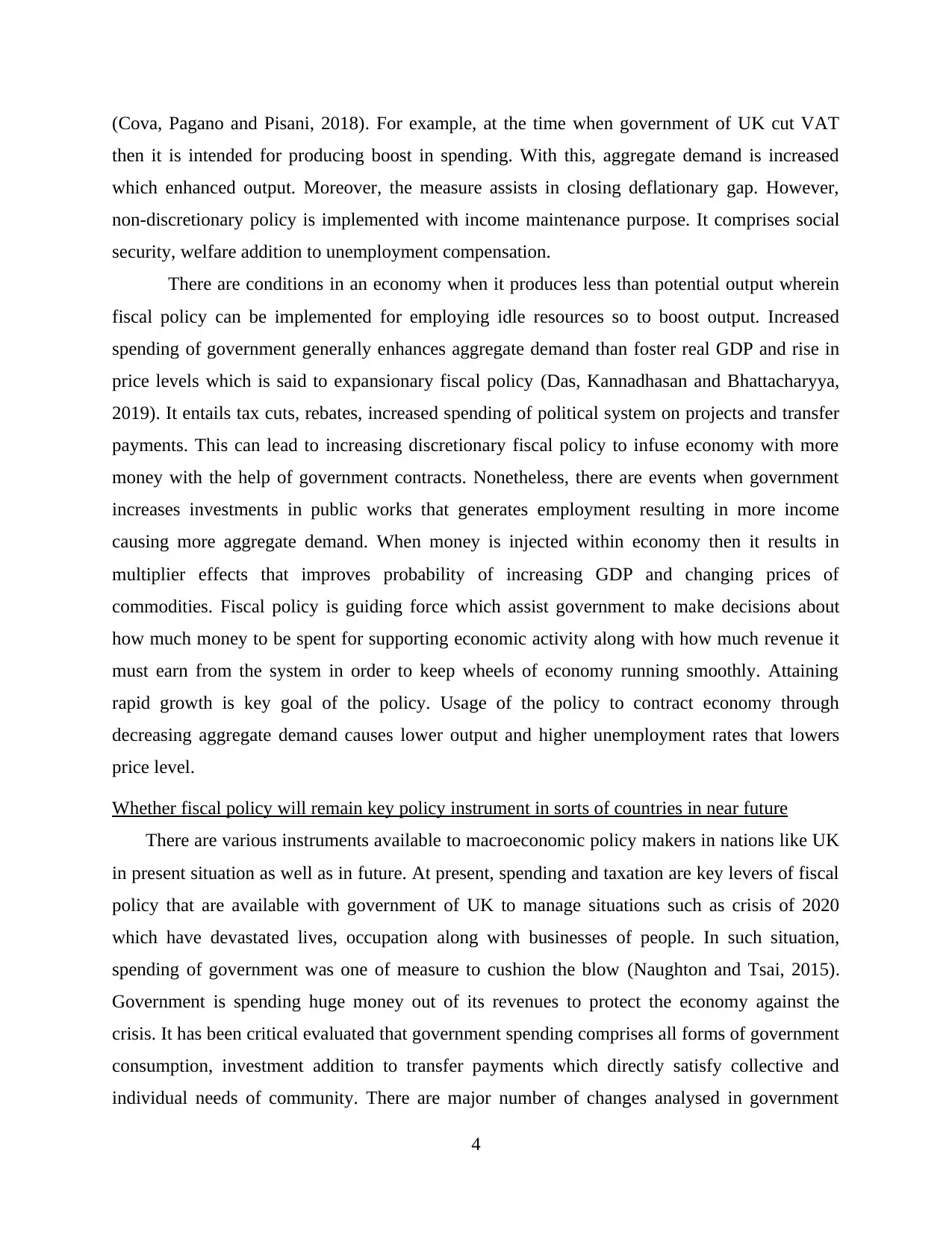
(Cova, Pagano and Pisani, 2018). For example, at the time when government of UK cut VAT
then it is intended for producing boost in spending. With this, aggregate demand is increased
which enhanced output. Moreover, the measure assists in closing deflationary gap. However,
non-discretionary policy is implemented with income maintenance purpose. It comprises social
security, welfare addition to unemployment compensation.
There are conditions in an economy when it produces less than potential output wherein
fiscal policy can be implemented for employing idle resources so to boost output. Increased
spending of government generally enhances aggregate demand than foster real GDP and rise in
price levels which is said to expansionary fiscal policy (Das, Kannadhasan and Bhattacharyya,
2019). It entails tax cuts, rebates, increased spending of political system on projects and transfer
payments. This can lead to increasing discretionary fiscal policy to infuse economy with more
money with the help of government contracts. Nonetheless, there are events when government
increases investments in public works that generates employment resulting in more income
causing more aggregate demand. When money is injected within economy then it results in
multiplier effects that improves probability of increasing GDP and changing prices of
commodities. Fiscal policy is guiding force which assist government to make decisions about
how much money to be spent for supporting economic activity along with how much revenue it
must earn from the system in order to keep wheels of economy running smoothly. Attaining
rapid growth is key goal of the policy. Usage of the policy to contract economy through
decreasing aggregate demand causes lower output and higher unemployment rates that lowers
price level.
Whether fiscal policy will remain key policy instrument in sorts of countries in near future
There are various instruments available to macroeconomic policy makers in nations like UK
in present situation as well as in future. At present, spending and taxation are key levers of fiscal
policy that are available with government of UK to manage situations such as crisis of 2020
which have devastated lives, occupation along with businesses of people. In such situation,
spending of government was one of measure to cushion the blow (Naughton and Tsai, 2015).
Government is spending huge money out of its revenues to protect the economy against the
crisis. It has been critical evaluated that government spending comprises all forms of government
consumption, investment addition to transfer payments which directly satisfy collective and
individual needs of community. There are major number of changes analysed in government
4
then it is intended for producing boost in spending. With this, aggregate demand is increased
which enhanced output. Moreover, the measure assists in closing deflationary gap. However,
non-discretionary policy is implemented with income maintenance purpose. It comprises social
security, welfare addition to unemployment compensation.
There are conditions in an economy when it produces less than potential output wherein
fiscal policy can be implemented for employing idle resources so to boost output. Increased
spending of government generally enhances aggregate demand than foster real GDP and rise in
price levels which is said to expansionary fiscal policy (Das, Kannadhasan and Bhattacharyya,
2019). It entails tax cuts, rebates, increased spending of political system on projects and transfer
payments. This can lead to increasing discretionary fiscal policy to infuse economy with more
money with the help of government contracts. Nonetheless, there are events when government
increases investments in public works that generates employment resulting in more income
causing more aggregate demand. When money is injected within economy then it results in
multiplier effects that improves probability of increasing GDP and changing prices of
commodities. Fiscal policy is guiding force which assist government to make decisions about
how much money to be spent for supporting economic activity along with how much revenue it
must earn from the system in order to keep wheels of economy running smoothly. Attaining
rapid growth is key goal of the policy. Usage of the policy to contract economy through
decreasing aggregate demand causes lower output and higher unemployment rates that lowers
price level.
Whether fiscal policy will remain key policy instrument in sorts of countries in near future
There are various instruments available to macroeconomic policy makers in nations like UK
in present situation as well as in future. At present, spending and taxation are key levers of fiscal
policy that are available with government of UK to manage situations such as crisis of 2020
which have devastated lives, occupation along with businesses of people. In such situation,
spending of government was one of measure to cushion the blow (Naughton and Tsai, 2015).
Government is spending huge money out of its revenues to protect the economy against the
crisis. It has been critical evaluated that government spending comprises all forms of government
consumption, investment addition to transfer payments which directly satisfy collective and
individual needs of community. There are major number of changes analysed in government
4
⊘ This is a preview!⊘
Do you want full access?
Subscribe today to unlock all pages.

Trusted by 1+ million students worldwide
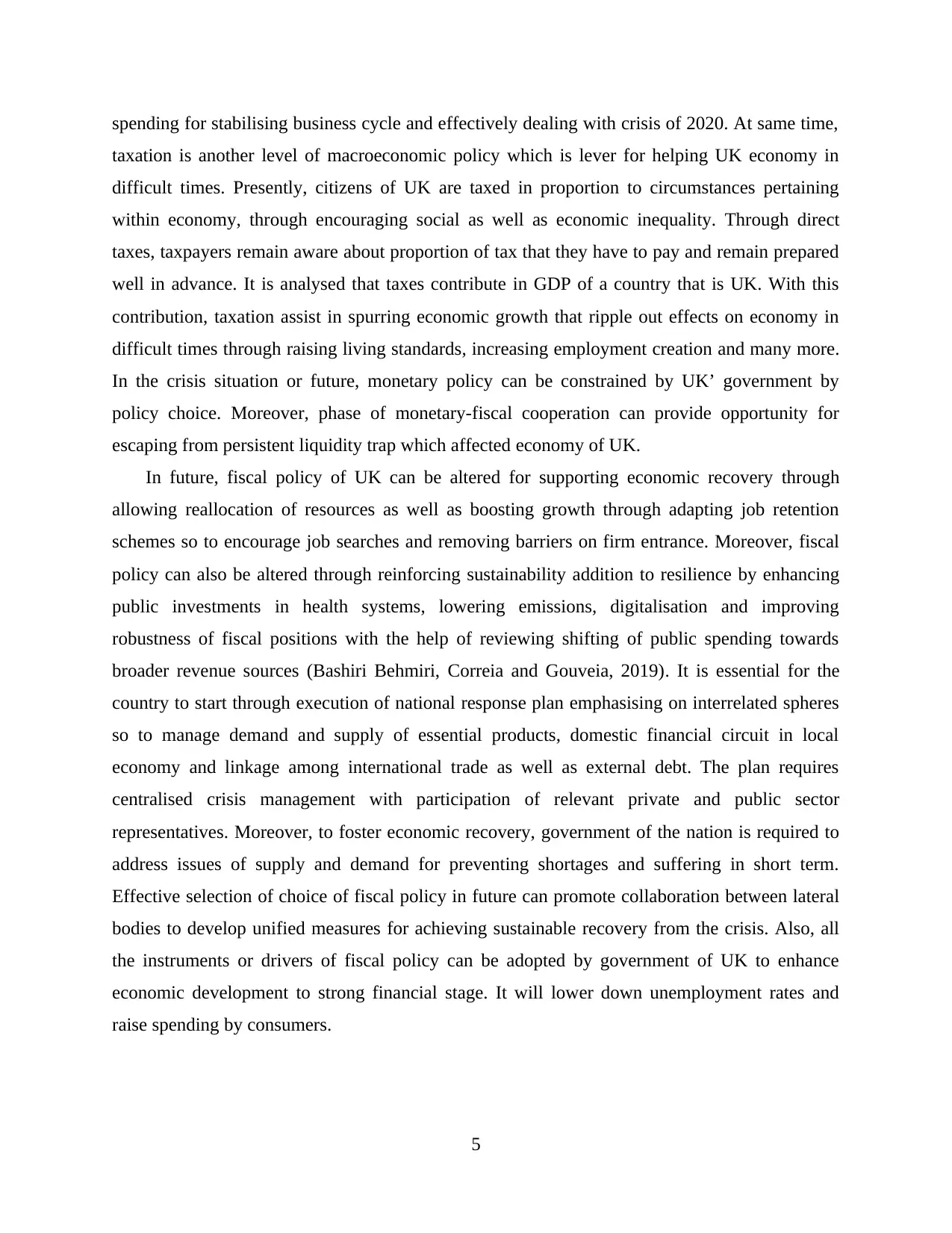
spending for stabilising business cycle and effectively dealing with crisis of 2020. At same time,
taxation is another level of macroeconomic policy which is lever for helping UK economy in
difficult times. Presently, citizens of UK are taxed in proportion to circumstances pertaining
within economy, through encouraging social as well as economic inequality. Through direct
taxes, taxpayers remain aware about proportion of tax that they have to pay and remain prepared
well in advance. It is analysed that taxes contribute in GDP of a country that is UK. With this
contribution, taxation assist in spurring economic growth that ripple out effects on economy in
difficult times through raising living standards, increasing employment creation and many more.
In the crisis situation or future, monetary policy can be constrained by UK’ government by
policy choice. Moreover, phase of monetary-fiscal cooperation can provide opportunity for
escaping from persistent liquidity trap which affected economy of UK.
In future, fiscal policy of UK can be altered for supporting economic recovery through
allowing reallocation of resources as well as boosting growth through adapting job retention
schemes so to encourage job searches and removing barriers on firm entrance. Moreover, fiscal
policy can also be altered through reinforcing sustainability addition to resilience by enhancing
public investments in health systems, lowering emissions, digitalisation and improving
robustness of fiscal positions with the help of reviewing shifting of public spending towards
broader revenue sources (Bashiri Behmiri, Correia and Gouveia, 2019). It is essential for the
country to start through execution of national response plan emphasising on interrelated spheres
so to manage demand and supply of essential products, domestic financial circuit in local
economy and linkage among international trade as well as external debt. The plan requires
centralised crisis management with participation of relevant private and public sector
representatives. Moreover, to foster economic recovery, government of the nation is required to
address issues of supply and demand for preventing shortages and suffering in short term.
Effective selection of choice of fiscal policy in future can promote collaboration between lateral
bodies to develop unified measures for achieving sustainable recovery from the crisis. Also, all
the instruments or drivers of fiscal policy can be adopted by government of UK to enhance
economic development to strong financial stage. It will lower down unemployment rates and
raise spending by consumers.
5
taxation is another level of macroeconomic policy which is lever for helping UK economy in
difficult times. Presently, citizens of UK are taxed in proportion to circumstances pertaining
within economy, through encouraging social as well as economic inequality. Through direct
taxes, taxpayers remain aware about proportion of tax that they have to pay and remain prepared
well in advance. It is analysed that taxes contribute in GDP of a country that is UK. With this
contribution, taxation assist in spurring economic growth that ripple out effects on economy in
difficult times through raising living standards, increasing employment creation and many more.
In the crisis situation or future, monetary policy can be constrained by UK’ government by
policy choice. Moreover, phase of monetary-fiscal cooperation can provide opportunity for
escaping from persistent liquidity trap which affected economy of UK.
In future, fiscal policy of UK can be altered for supporting economic recovery through
allowing reallocation of resources as well as boosting growth through adapting job retention
schemes so to encourage job searches and removing barriers on firm entrance. Moreover, fiscal
policy can also be altered through reinforcing sustainability addition to resilience by enhancing
public investments in health systems, lowering emissions, digitalisation and improving
robustness of fiscal positions with the help of reviewing shifting of public spending towards
broader revenue sources (Bashiri Behmiri, Correia and Gouveia, 2019). It is essential for the
country to start through execution of national response plan emphasising on interrelated spheres
so to manage demand and supply of essential products, domestic financial circuit in local
economy and linkage among international trade as well as external debt. The plan requires
centralised crisis management with participation of relevant private and public sector
representatives. Moreover, to foster economic recovery, government of the nation is required to
address issues of supply and demand for preventing shortages and suffering in short term.
Effective selection of choice of fiscal policy in future can promote collaboration between lateral
bodies to develop unified measures for achieving sustainable recovery from the crisis. Also, all
the instruments or drivers of fiscal policy can be adopted by government of UK to enhance
economic development to strong financial stage. It will lower down unemployment rates and
raise spending by consumers.
5
Paraphrase This Document
Need a fresh take? Get an instant paraphrase of this document with our AI Paraphraser
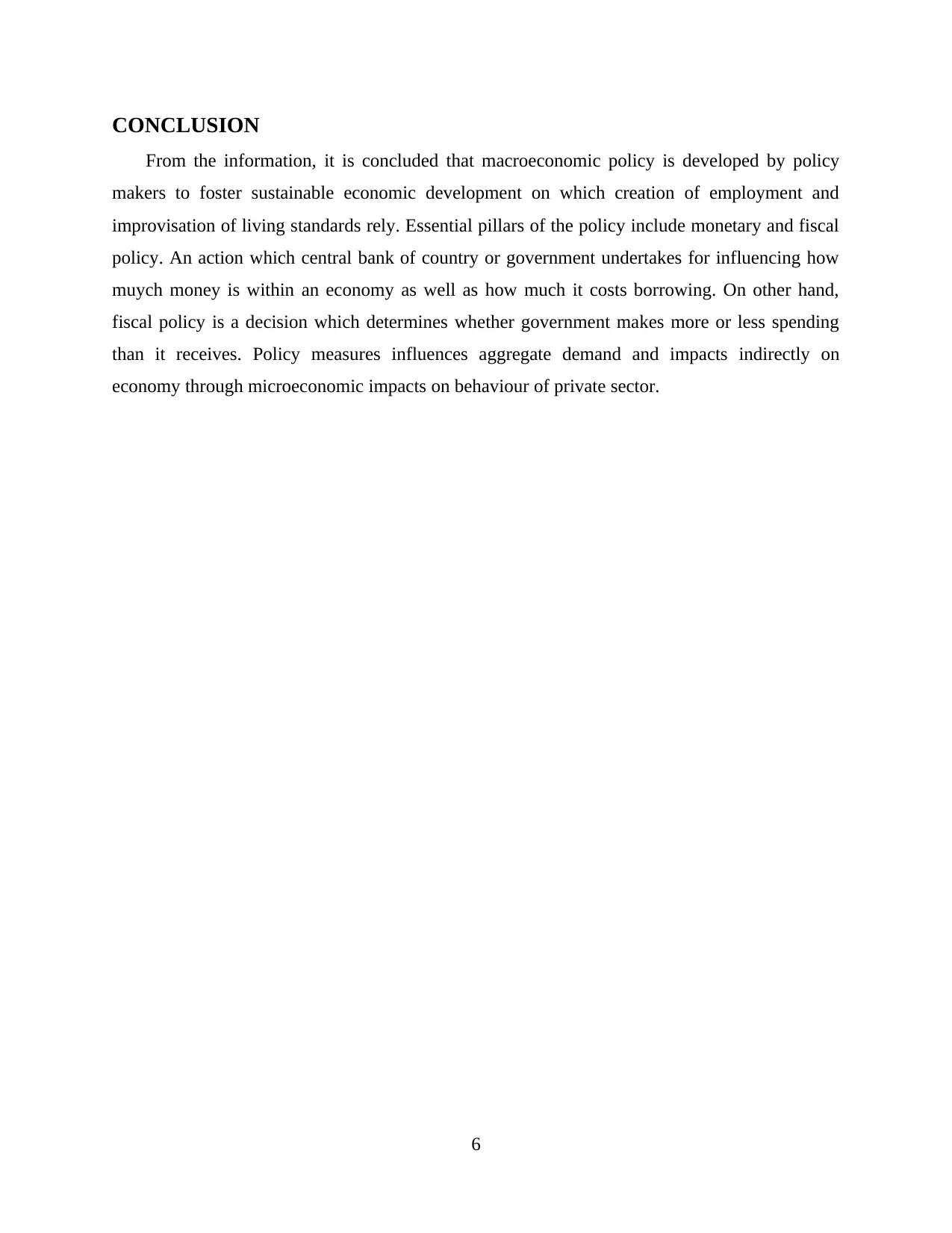
CONCLUSION
From the information, it is concluded that macroeconomic policy is developed by policy
makers to foster sustainable economic development on which creation of employment and
improvisation of living standards rely. Essential pillars of the policy include monetary and fiscal
policy. An action which central bank of country or government undertakes for influencing how
muych money is within an economy as well as how much it costs borrowing. On other hand,
fiscal policy is a decision which determines whether government makes more or less spending
than it receives. Policy measures influences aggregate demand and impacts indirectly on
economy through microeconomic impacts on behaviour of private sector.
6
From the information, it is concluded that macroeconomic policy is developed by policy
makers to foster sustainable economic development on which creation of employment and
improvisation of living standards rely. Essential pillars of the policy include monetary and fiscal
policy. An action which central bank of country or government undertakes for influencing how
muych money is within an economy as well as how much it costs borrowing. On other hand,
fiscal policy is a decision which determines whether government makes more or less spending
than it receives. Policy measures influences aggregate demand and impacts indirectly on
economy through microeconomic impacts on behaviour of private sector.
6
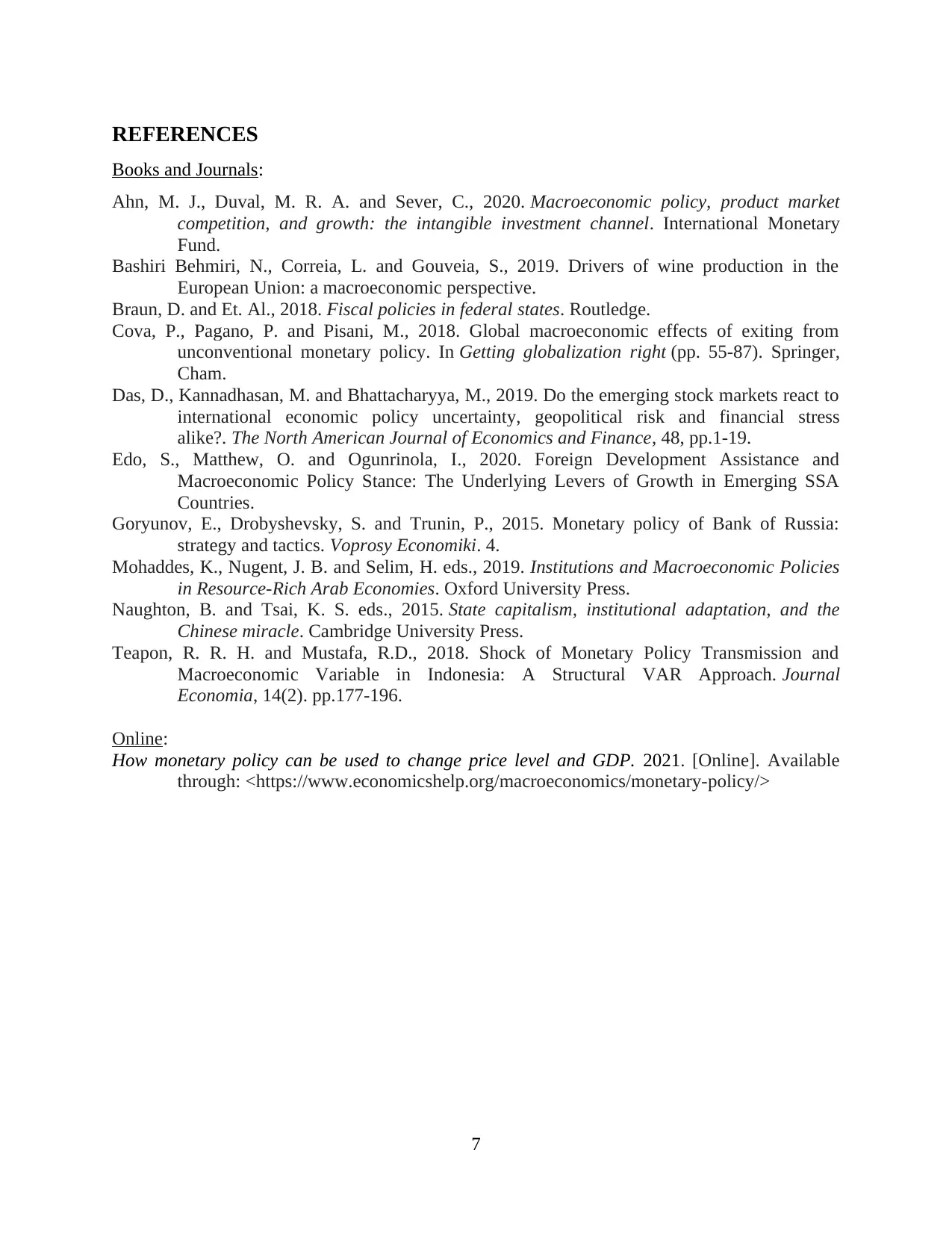
REFERENCES
Books and Journals:
Ahn, M. J., Duval, M. R. A. and Sever, C., 2020. Macroeconomic policy, product market
competition, and growth: the intangible investment channel. International Monetary
Fund.
Bashiri Behmiri, N., Correia, L. and Gouveia, S., 2019. Drivers of wine production in the
European Union: a macroeconomic perspective.
Braun, D. and Et. Al., 2018. Fiscal policies in federal states. Routledge.
Cova, P., Pagano, P. and Pisani, M., 2018. Global macroeconomic effects of exiting from
unconventional monetary policy. In Getting globalization right (pp. 55-87). Springer,
Cham.
Das, D., Kannadhasan, M. and Bhattacharyya, M., 2019. Do the emerging stock markets react to
international economic policy uncertainty, geopolitical risk and financial stress
alike?. The North American Journal of Economics and Finance, 48, pp.1-19.
Edo, S., Matthew, O. and Ogunrinola, I., 2020. Foreign Development Assistance and
Macroeconomic Policy Stance: The Underlying Levers of Growth in Emerging SSA
Countries.
Goryunov, E., Drobyshevsky, S. and Trunin, P., 2015. Monetary policy of Bank of Russia:
strategy and tactics. Voprosy Economiki. 4.
Mohaddes, K., Nugent, J. B. and Selim, H. eds., 2019. Institutions and Macroeconomic Policies
in Resource-Rich Arab Economies. Oxford University Press.
Naughton, B. and Tsai, K. S. eds., 2015. State capitalism, institutional adaptation, and the
Chinese miracle. Cambridge University Press.
Teapon, R. R. H. and Mustafa, R.D., 2018. Shock of Monetary Policy Transmission and
Macroeconomic Variable in Indonesia: A Structural VAR Approach. Journal
Economia, 14(2). pp.177-196.
Online:
How monetary policy can be used to change price level and GDP. 2021. [Online]. Available
through: <https://www.economicshelp.org/macroeconomics/monetary-policy/>
7
Books and Journals:
Ahn, M. J., Duval, M. R. A. and Sever, C., 2020. Macroeconomic policy, product market
competition, and growth: the intangible investment channel. International Monetary
Fund.
Bashiri Behmiri, N., Correia, L. and Gouveia, S., 2019. Drivers of wine production in the
European Union: a macroeconomic perspective.
Braun, D. and Et. Al., 2018. Fiscal policies in federal states. Routledge.
Cova, P., Pagano, P. and Pisani, M., 2018. Global macroeconomic effects of exiting from
unconventional monetary policy. In Getting globalization right (pp. 55-87). Springer,
Cham.
Das, D., Kannadhasan, M. and Bhattacharyya, M., 2019. Do the emerging stock markets react to
international economic policy uncertainty, geopolitical risk and financial stress
alike?. The North American Journal of Economics and Finance, 48, pp.1-19.
Edo, S., Matthew, O. and Ogunrinola, I., 2020. Foreign Development Assistance and
Macroeconomic Policy Stance: The Underlying Levers of Growth in Emerging SSA
Countries.
Goryunov, E., Drobyshevsky, S. and Trunin, P., 2015. Monetary policy of Bank of Russia:
strategy and tactics. Voprosy Economiki. 4.
Mohaddes, K., Nugent, J. B. and Selim, H. eds., 2019. Institutions and Macroeconomic Policies
in Resource-Rich Arab Economies. Oxford University Press.
Naughton, B. and Tsai, K. S. eds., 2015. State capitalism, institutional adaptation, and the
Chinese miracle. Cambridge University Press.
Teapon, R. R. H. and Mustafa, R.D., 2018. Shock of Monetary Policy Transmission and
Macroeconomic Variable in Indonesia: A Structural VAR Approach. Journal
Economia, 14(2). pp.177-196.
Online:
How monetary policy can be used to change price level and GDP. 2021. [Online]. Available
through: <https://www.economicshelp.org/macroeconomics/monetary-policy/>
7
⊘ This is a preview!⊘
Do you want full access?
Subscribe today to unlock all pages.

Trusted by 1+ million students worldwide
1 out of 9
Related Documents
Your All-in-One AI-Powered Toolkit for Academic Success.
+13062052269
info@desklib.com
Available 24*7 on WhatsApp / Email
![[object Object]](/_next/static/media/star-bottom.7253800d.svg)
Unlock your academic potential
Copyright © 2020–2025 A2Z Services. All Rights Reserved. Developed and managed by ZUCOL.




